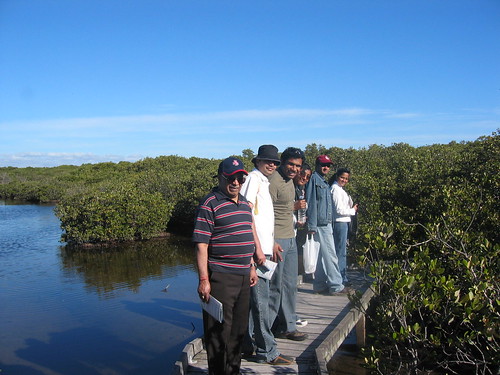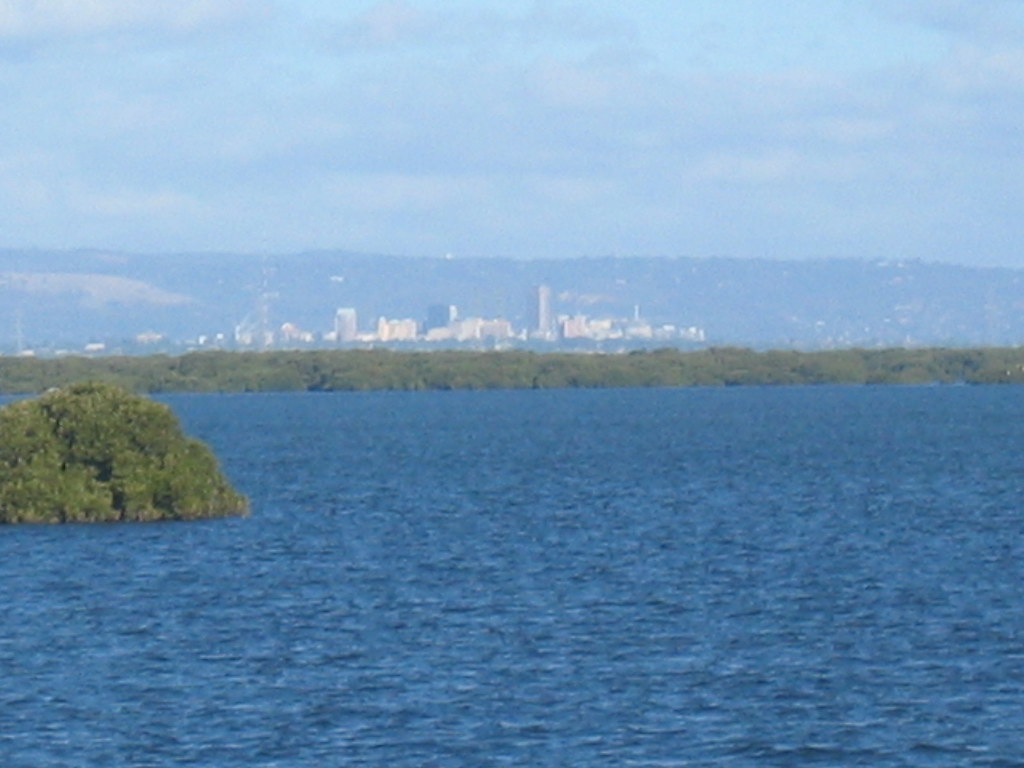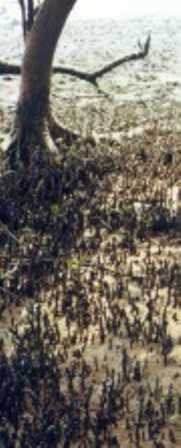Mangrove Trail @ St.Kilda
St. Kilda is a place not very far from Adelaide (about 20 minutes drive from Gepps Cross towards Pt. Wakefield). I had heard about it from my husband's friend. The speciality about this place is that it has an unusual trail which is about 2 kilometres long on a swamp land filled with an uncommon tree called Mangrove.

The trail is actually a boardwalk that meanders through a forest formed by these Mangrove trees on backwaters and salt marshes. Mangrove as the name may suggest has nothing in common to our sweet Mangoes. These plants in fact produce a fruit similar to berries and although we were not able to taste it, found out that it was salty. What is so unusual about these plants is that since they thrive in swamp areas, their roots are anaerobic and cannot get enough oxygen required for photosynthesis. In order to inhale oxygen the roots tend to grow above the ground and they look like little fingers growing all over near the parent tree. When the tree grows older, apparently the roots even grow on the trunk and branches in order to fetch enough oxygen to keep it surviving. It is so surprising to see how nature takes care of itself.
The leaves of the Mangrove trees are small and green. They have crystals of white salt on their surface resembling morning dew. Our group was bold enough to taste the crystalline formation and we were amazed that the taste was the same as cooking salt. Some of us were even considering plucking a few leaves in order to save salt expense (El-cheapos)! According to the information guide given to us before we started the boardwalk, the concentration of salt in the backwaters is so much that it seeps through the trunk to the leaves of the tree. That also explains why the fruit is salty.
The flowers born by the tree have a beautiful fragrance that lingers in some part of the trail. These flowers then become fruits containing seeds. These fruits fall close to the parent tree and the seedlings give birth to daughters growing under the parents’ wings. If we thought only fauna had attachment towards their young ones, looks like we were mistaken!

These trees are home to various types of creatures both under water and above. The underwater creatures consist of various types of fishes, dolphins, crabs and tadpoles. Other creatures taking shelter in the Mangroves include spiders, mosquitoes and different types of birds.
The spiders are interesting species with respect to their habitat. In the Mangroves, the spiders form intricate webs (which would be intriguing to the best of architects) and the most astonishing thing was how each of the million webs had a single curled up dry leaf suspended at the centre. The logic behind this was that they could hide in the curl of the leaf from falling victims to birds. The web played an active role in catching prey for the spiders. I never realised until then the importance of the spider web. We noticed a few insects trapped in some of the webs and thought that those spiders were going to have a gala feast that night!
Coexisting with the Mangroves in this forest are Samphires. Samphires are smaller plants in green and red colours. They taste like a common vegetable with a salty tinge. In fact, these Samphires literally fight for space with the Mangroves. A combination of these two plants gives the dense forest a very pleasant feel. The 2 kilometre walk went like a breeze since we were beneath the canopy of the Mangroves and the atmosphere was moist, even though the sun was blazing outside.
After the Mangrove trail, we went to this huge playground meant for kids at St. Kilda. There were about a 1000 kids of various ages playing in the giant slides, swings, see-saws etc. Even we adults felt like kids once we were there and began to play in some of those big toys. It was a beautiful experience remembering how carefree we were while we were young. The playground was very colourful and was a perfect end to a wonderful day.


The trail is actually a boardwalk that meanders through a forest formed by these Mangrove trees on backwaters and salt marshes. Mangrove as the name may suggest has nothing in common to our sweet Mangoes. These plants in fact produce a fruit similar to berries and although we were not able to taste it, found out that it was salty. What is so unusual about these plants is that since they thrive in swamp areas, their roots are anaerobic and cannot get enough oxygen required for photosynthesis. In order to inhale oxygen the roots tend to grow above the ground and they look like little fingers growing all over near the parent tree. When the tree grows older, apparently the roots even grow on the trunk and branches in order to fetch enough oxygen to keep it surviving. It is so surprising to see how nature takes care of itself.
The leaves of the Mangrove trees are small and green. They have crystals of white salt on their surface resembling morning dew. Our group was bold enough to taste the crystalline formation and we were amazed that the taste was the same as cooking salt. Some of us were even considering plucking a few leaves in order to save salt expense (El-cheapos)! According to the information guide given to us before we started the boardwalk, the concentration of salt in the backwaters is so much that it seeps through the trunk to the leaves of the tree. That also explains why the fruit is salty.
The flowers born by the tree have a beautiful fragrance that lingers in some part of the trail. These flowers then become fruits containing seeds. These fruits fall close to the parent tree and the seedlings give birth to daughters growing under the parents’ wings. If we thought only fauna had attachment towards their young ones, looks like we were mistaken!

These trees are home to various types of creatures both under water and above. The underwater creatures consist of various types of fishes, dolphins, crabs and tadpoles. Other creatures taking shelter in the Mangroves include spiders, mosquitoes and different types of birds.
The spiders are interesting species with respect to their habitat. In the Mangroves, the spiders form intricate webs (which would be intriguing to the best of architects) and the most astonishing thing was how each of the million webs had a single curled up dry leaf suspended at the centre. The logic behind this was that they could hide in the curl of the leaf from falling victims to birds. The web played an active role in catching prey for the spiders. I never realised until then the importance of the spider web. We noticed a few insects trapped in some of the webs and thought that those spiders were going to have a gala feast that night!
Coexisting with the Mangroves in this forest are Samphires. Samphires are smaller plants in green and red colours. They taste like a common vegetable with a salty tinge. In fact, these Samphires literally fight for space with the Mangroves. A combination of these two plants gives the dense forest a very pleasant feel. The 2 kilometre walk went like a breeze since we were beneath the canopy of the Mangroves and the atmosphere was moist, even though the sun was blazing outside.
After the Mangrove trail, we went to this huge playground meant for kids at St. Kilda. There were about a 1000 kids of various ages playing in the giant slides, swings, see-saws etc. Even we adults felt like kids once we were there and began to play in some of those big toys. It was a beautiful experience remembering how carefree we were while we were young. The playground was very colourful and was a perfect end to a wonderful day.

0 Comments:
Post a Comment
<< Home